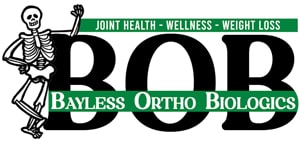Alpha-2-Macroglobulin (A2M) Injections
What are Alpha-2-Macroglobulin (A2M) Injections?
Alpha-2-Macroglobulin (A2M) injections are a new and highly advanced regenerative treatment for osteoarthritis and other painful orthopedic disorders. Osteoarthritis is a degenerative joint disease that causes breakdown and eventual loss of cartilage in the joint, causing a painful rubbing of bone surfaces with movement.
A2M is a human plasma protein molecule that occurs naturally in your blood. This molecule is a powerful inhibitor of cartilage catabolic factors because it slows down the breakdown of cartilage as well as prevents loss of cartilage and when injected into the osteoarthritic or painful area, begins to promote healing.
A2M is derived from blood drawn in the office and then processed to be injected into the affected area. Once injected, A2M attaches to and removes destructive enzymes, called proteases. These proteases harm the cartilage cells and tissues and cause osteoarthritis in the joint or disc space. An A2M injection comprises a concentrated dose of the molecule that is about 6 times more than what already occurs in your body naturally. When this amount of A2M is directly injected into the arthritic joint or disc space, it can bind and remove the destructive enzymes that are damaging the cartilage and tissues.
Indications for Alpha-2-Macroglobulin (A2M) Injections
Alpha-2-Macroglobulin (A2M) injections are most commonly indicated to treat joint osteoarthritis symptoms, such as pain, swelling, and inflammation. When traditional conservative remedies such as medications, physical therapy, lifestyle modifications, and heat and ice therapy have failed to provide symptomatic relief or when other injections such as corticosteroid or hyaluronic acid have provided mixed results, A2M injections may be administered directly into the joints to ease arthritic symptoms and restore joint function.
An A2M Injection may have remarkable benefits compared to other osteoarthritis treatments such as medications and steroid injections. Other treatments may help relieve symptoms temporarily whereas A2M injections can help heal, rejuvenate, and repair damaged tissue and cartilage.
In addition, A2M can also be used to treat other joint pain conditions, such as:
- Joint injuries, such as hip, knee, and shoulder
- Torn meniscus
- Labral Tear
- Lumbar and sacral osteoarthritis
- Spinal injuries, such as neck and back
- Sciatica (lumbar radiculopathy)
- Coccydynia
- Herniated disc (disc displacement, slipped disc)
- Degenerative disc disease
Preparation for Alpha-2-Macroglobulin (A2M) Injections
Your doctor will review your medical history thoroughly before the procedure. You must inform your doctor about any health conditions you have such as diabetes or bleeding disorders, and about any medications you are taking, such as blood thinners or anti-inflammatories, or any supplements you are on. You may be asked to stop taking certain medicines for several days before the procedure. You will be instructed not to consume any food or drink for several hours prior to the procedure. You should also arrange for someone to drive you home after the procedure. A signed informed consent form will be obtained from you after the pros and cons of the procedure has been explained.
Procedure for Alpha-2-Macroglobulin (A2M) Injections
Alpha-2-Macroglobulin (A2M) injections are administered as an outpatient procedure in a clinic setting under local anesthesia. You will be asked to lie down on the procedure table in a position that is ideal for the administration of A2M injection. The treatment area is cleaned with an antiseptic solution. The injection is performed using fluoroscopy (real-time x-ray imaging) or CT scans to assist the doctor in placing the needle accurately to target the treatment area so the patient can derive maximum benefit. A blood sample is obtained from the patient, and the sample is processed using a specialized centrifuge to separate the blood and the plasma. The plasma is further processed to produce a concentrated A2M. Under image guidance, the A2M injection is administered directly into the affected joint to promote healing. The A2M injections may effectively stop the destruction of cartilage observed and experienced in osteoarthritis. A small dressing is applied at the site of the injection to complete the procedure.
Post-procedure Care and Recovery
After the procedure, you will be taken to the recovery room for observation. The anesthetic utilized to numb the skin usually wears off in 1 to 2 hours. Mild swelling and pain may occur at the site of injection during this time. Rest, elevation, and medicines are recommended to relieve pain and swelling. In addition, you may apply cold compresses on the injection site for comfort. Most of the patients will be able to resume their normal activities with no downtime.
Benefits of Alpha-2-Macroglobulin (A2M) Injections
Some of the benefits of A2M injections include:
- Prevents further cartilage loss
- Promotes growth of healthy tissue around the joint
- Improves overall joint function
- Provides an alternative to surgery
Risks and Side Effects
Alpha-2-Macroglobulin is obtained from your own blood (autologous), so there is little to no risk involved when the injection is administered by a trained health professional. Additionally, since the cells are autologous, there is no possibility of having an immune or allergic reaction. Side effects of complications of A2M are very rare. Consult your healthcare provider for more information.
Summary
When administered to a localized area of abnormality, alpha-2-Macroglobulin injections can offer a significant improvement in symptoms over the course of healing time. This injection may rule out the requirement for more invasive treatments, such as prolonged use of medications or surgery. While other treatments such as corticosteroid injections may offer temporary relief and stop pain and inflammation, A2M injections stimulate healing of the injured area over a short period of time with minimal to no side effects. Individuals report improvement in symptoms and return to function in no less than 4 to 6 weeks. Many patients require 2 to 3 treatments before the injured tissues are completely healed and may experience dramatic relief from symptoms and return to function.









